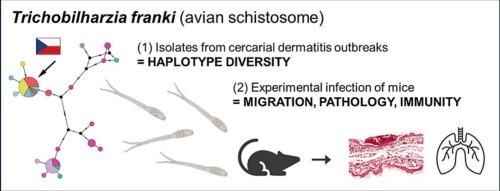The avian schistosome Trichobilharzia franki in mice: Migration, pathogenicity, and the host immune response
IF 3.1
Q2 PARASITOLOGY
引用次数: 0
Abstract
Cercarial dermatitis (CD; swimmer's itch) is a re-emerging skin disease caused by avian schistosomes, including Trichobilharzia franki. Here, we present morphological, genetic, and experimental evidence confirming the involvement of T. franki in recent CD outbreaks across Czechia. Ocellate furcocercariae were collected from Radix auricularia at four sites and identified as T. franki through ITS1 sequencing. Despite minor morphological differences from previously reported specimens, all isolates belonged to the genetically uniform T. franki “auricularia” clade. Experimental infection of mice with T. franki resulted in a ∼ 60 % penetration rate, accompanied by early-onset scratching and transient weight loss. Gross pathology demonstrated hemorrhages on lung surfaces and splenic atrophy at 2 days post-infection (dpi), along with a prominent enlargement of parotid lymph nodes at both 2 and 7 dpi. Histological examination of the skin revealed viable schistosomula, moderate leukocyte infiltration, epidermal hyperplasia, and the formation of hyperkeratotic crusts at 2 dpi. By 7 dpi, parasites were no longer detectable, but epidermal pathology persisted. In the lungs, eosinophil-rich foci and multifocal hemorrhages were observed at 2 dpi, transitioning to neutrophil-dominated lesions at 7 dpi, despite the absence of detectable schistosomula. Splenocytes from infected mice responded to homologous and heterologous cercarial antigens by producing IFN gamma, IL-4, and IL-10, indicating a mixed Th1/Th2/Treg profile and notable species cross-reactivity. However, parasite-specific IgG remained undetectable at 7 dpi. These findings confirm T. franki as the causative agent of CD outbreaks and underscore its capacity to induce localized and systemic pathology and immune response, cross-reacting with other schistosomes.

禽弗兰基毛叉虫在小鼠中的迁移、致病性和宿主免疫反应
子宫颈皮炎(游泳者瘙痒)是一种由禽血吸虫引起的复发性皮肤病,包括弗兰基毛叉虫。在这里,我们提出形态学、遗传学和实验证据,证实弗兰基弓形虫参与了最近在捷克暴发的乳糜病。从木耳4个地点采集到细胞状毛尾蚴,经ITS1测序鉴定为franki绦虫。尽管与先前报道的标本有微小的形态学差异,但所有分离株都属于遗传上一致的弗兰基木耳菌支系。在实验中,小鼠感染弗兰基弓形虫导致约60%的穿刺率,并伴有早发性抓伤和短暂的体重减轻。大体病理显示感染后2天肺表面出血和脾萎缩,并在感染后2和7天腮腺淋巴结明显肿大。皮肤组织学检查显示活血吸虫,中度白细胞浸润,表皮增生,2 dpi处角化痂形成。到7 dpi时,寄生虫不再被检测到,但表皮病理仍然存在。在肺中,尽管没有检测到血吸虫,但在2 dpi时观察到嗜酸性粒细胞丰富的灶和多灶性出血,在7 dpi时转变为中性粒细胞为主的病变。感染小鼠的脾细胞通过产生IFN γ、IL-4和IL-10对同源和异源尾蚴抗原产生应答,表明Th1/Th2/Treg混合谱和显著的物种交叉反应性。然而,在7 dpi时仍未检测到寄生虫特异性IgG。这些发现证实了弗兰基弓形虫是乳糜泻暴发的病原体,并强调了其诱导局部和全身病理和免疫反应的能力,与其他血吸虫交叉反应。
本文章由计算机程序翻译,如有差异,请以英文原文为准。
求助全文
约1分钟内获得全文
求助全文
来源期刊

Food and Waterborne Parasitology
Immunology and Microbiology-Parasitology
CiteScore
5.10
自引率
4.00%
发文量
38
审稿时长
13 weeks
期刊介绍:
Food and Waterborne Parasitology publishes high quality papers containing original research findings, investigative reports, and scientific proceedings on parasites which are transmitted to humans via the consumption of food or water. The relevant parasites include protozoa, nematodes, cestodes and trematodes which are transmitted by food or water and capable of infecting humans. Pertinent food includes products of animal or plant origin which are domestic or wild, and consumed by humans. Animals and plants from both terrestrial and aquatic sources are included, as well as studies related to potable and other types of water which serve to harbor, perpetuate or disseminate food and waterborne parasites. Studies dealing with prevalence, transmission, epidemiology, risk assessment and mitigation, including control measures and test methodologies for parasites in food and water are of particular interest. Evidence of the emergence of such parasites and interactions among domestic animals, wildlife and humans are of interest. The impact of parasites on the health and welfare of humans is viewed as very important and within scope of the journal. Manuscripts with scientifically generated information on associations between food and waterborne parasitic diseases and lifestyle, culture and economies are also welcome. Studies involving animal experiments must meet the International Guiding Principles for Biomedical Research Involving Animals as issued by the Council for International Organizations of Medical Sciences.
 求助内容:
求助内容: 应助结果提醒方式:
应助结果提醒方式:


